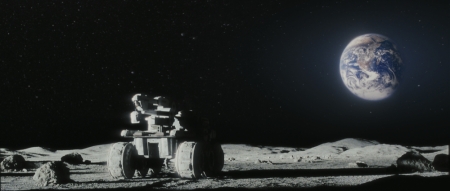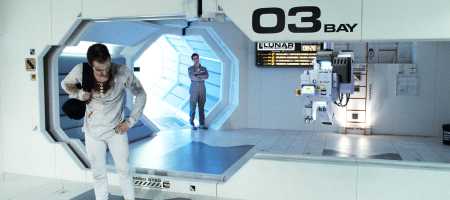#29: Moon
Director: Duncan Jones
Cast: Sam Rockwell, Kevin Spacey
Introduction Plot Summary Impressions Wrap-up
My rating: Class B (2/7, hot white star). Originally written as a vehicle for Sam Rockwell, this movie transcends its roots with an intriguing mystery and an all-too-human story of a man alone on the far side of the moon at a mining base called Sarang. Haunting and tragic, the movie is interesting whether you know the story or not, and it’s definitely worth a look.
*** Please consider yourself warned: The trailer gives away some of the mystery! ***
This movie, originally written as a vehicle for Sam Rockwell, is also the feature directorial debut of Duncan Jones—who is also known as “Zowie Bowie,” from his middle name and his famous father’s (that’s David Bowie to those of you not in the know) stage name. It premiered at the Sundance Film Festival in 2009, and was subsequently released to select theaters in the United States and Britain. No doubt about it, this movie is an artsy and ambitious one, though it feels like a feature film rather than an art film.
It’s also compelling and extraordinary, with a $5 million budget so it feels…well, like a real movie that someone spent time and energy putting together. It grossed about $9.7 million, and was apparently never in wide release. Not an art film, it is nevertheless not a traditional commercial movie. It’s a psychodrama with some traces of action and adventure.
The movie is a thoughtful glimpse into a near-future which most of us would probably enjoy—as long as we didn’t know about the seamy underside of that future, which the movie slowly, carefully exposes to the viewer. A large part of the trip is the nasty surprises on the way, so I’m going to warn you as we go when I’m providing information you wouldn’t have as you watch the movie. Read the spoilers at your own risk!
Short summary (no spoilers): Sam Bell is a lone astronaut and caretaker at the Sarang Lunar Base, located on the far side of the Moon. The base is a largely automated mining facility which processes HE-3 from the lunar surface and sends it back to Earth. There’s been some kind of acccident with the communication satellite, so Sam doesn’t have real time communication with Earth. Sam has only the robot GERTY for company—GERTY is not a humanoid robot, but rather a near-future industrial sort of thing that can only travel on rails in the ceiling. Sam’s starting to hallucinate, and suspects that his employer, the consortium LUNAR, is up to no good with only three weeks to go on his contract…
Sam sets out for one of the mining units to pick up a load of HE-3 in a lunar rover. He hallucinates again, loses control of the rover, and hits and damages the mining unit. Oh boy…that’s not good.
Sam wakes up in the infirmary, and GERTY tells him he’s had an accident. His memory may return.
This was the point where I put the whole movie together and spent the rest of it knowing that everything going on was precisely as bad as I had anticipated.
*** More Spoilers!! ***
Sam is informed that a rescue crew is coming and that he is not to leave the base. Sam engineers an accident, though, so he can leave the base to inspect for micrometeroite impacts…and goes to the wrecked rover and mining unit, where he takes an injured, space-suited man out of the rover and back to the infirmary.
He’s just rescued an exact physical duplicate of himself.
And now you have the full information the trailer presents, and the rest of the movie is about what the heck is going on, the essential wierdness of two Sam Bells on the mining base.
As has become my custom, I’ll start off with the visuals and sound, move to the acting, and only then deal with the script and themes and finally the science. Unfortunately, that means that the second half of my impressions will have some spoilers—but I’ll try to warn you as they come along.
Visually, the film is a sort of sterile affair, as the surface of the moon is a stark black-and-white affair, and the moonbase is a sterile, if clean, industrial place with only a few homey touches (Sam’s recliner, his model of a town, and his bed alcove with its pictures). That’s quite deliberate, and it feeds into Sam’s isolation and loneliness.
The music is good—it’s haunting, modern without being so tech-sounding it’s irritating, and it matches the visuals perfectly.
In many ways, this is the Sam Rockwell show. There are other actors in the film, but for most of it, Rockwell has to carry the load by himself—not unlike a few other movies in the Top 50 list, and possibly an insight into how well science fiction themes and settings translate into stories about loneliness. Rockwell does an amazing job and carries the film without any trouble.
What’s really interesting is that Rockwell manages, with the help of a good script, to portray the two Sam Bells as if they are different people. And they are—one Sam has been awake and aware for nearly three years, isolated and with his body beginning to fail, and he’s had time to work on his anger issues. The other Sam is new and fresh and without preconceptions—but brash and hot-tempered. Their reactions to their situation are very different, and it’s clear that the second Sam hasn’t figured out everything that the first Sam does—though he doesn’t have all the clues, either…
The only other character who gets close to as much screen time as Sam is GERTY, the robot voiced by Kevin Spacey. He sounds a lot like HAL from 2001, but couldn’t be more different: it seems his sole job is to make Sam’s time at Sarang easier—a programming choice that leads to trouble for LUNAR. Spacey gives a carefully modulated performance which is considered and thoughtful, without actually creating a real persona. That’s an achievement in and of itself, all things considered.
The script is very careful about how it doles out the mystery, and the revelations, doled out in a careful order and pace, hearken back to the science fiction movies of the 1950s. Indeed, the script is very well-constructed; the first twist, that there are two Sams, comes very early. The viewer won’t necessarily figure out what’s going on from that point, though the movie is honest enough for it to be possible. Even if the viewer gets the full ramifications of the two Sams right off the bat, the movie is still fun, as you watch the two Sams slowly figure out what is actually going on.
There are lots of nice little touches in the film. Ironically, Sarang is Korean for “love,” and the symbols which appear after “Sarang” all over the base are the Korean letters for the same word (the symbols are in hangul). Given what LUNAR does to Sam, that’s a nicely ironic name for the base…Sam 1’s deterioration is heart-rending to watch. It’s also viscerally disturbing: he bleeds easily, has trouble staying in shape, looses teeth, and vomits blood. For me, I knew Sam 1 was dying; his skin even has a pallor which Sam 2 lacks.
The science in the movie is absolutely dead on. First, Sarang is on the far side of the moon. The moon is tidally locked to the Earth, which means that its period of rotation and its orbit are equal—which in turn means that the moon keeps one side perpertually turned toward the Earth, and the other away. Though the far side of the moon is fancifully referred to as the dark side of the moon, both sides do receive sunlight, and the movie gets that right.
HE-3 is another piece of science which the movie nailed. Helium three, as it should be called, is an isotope of the element helium containing two protons, two electrons, and only one neutron (instead of the “standard” two neutrons). The interesting thing about helium three is that it would make an excellent fuel for fusion reactions, since at least one of the possible fusion pathways would not emit high energy neutrons. And that’s important because neutron emission—also known as neutron activation—is the only way that non-radioactive materials can become radioactive. Neutron activation, as it turns out, causes lots of problems with fission reactors and, if we can get fusion reactors working, will be similarly problematic with them: it renders the shielding, components, and everything else inside the reactor radioactive, and is a significant source of radioactive waste. And guess where you can find a lot of helium three? That’s right, on the surface of the moon, deposited there by the solar winds.
The last major element of the science in the movie is cloning, and there the movie does take some liberties. It’s clear that we can’t yet clone people, but if we do successfully manage it, shortened lifespans should be a consequence (though we don’t fully understand the aging process, shortened telomeres, which are a consequence of cell division, will be a problem, and the cloned human will have telomeres of the same length as the original; they might even be something we could deliberately shorten as part of the process…). The part where the movie takes liberties, of course, is in the implantation of memories; right now we have no idea how to do that, though with advances in medical technology it may become possible…
This is not a fun movie, but it’s well worth watching if you’re in the mood for a thoughtful and thought-provoking science fiction movie. Sam Rockwell’s performance is very good, and he really does make the movie. But this cautionary tale about what we might do with advances in technology also shows us the darker side of human nature, something science fiction has always done well. The story is ultimately a sad one, but it’s a lot of fun with an intriguing mystery which gets almost everything right.
Related articles
- Moon (scienceinthepub.co.uk)
- Retro Review: Moon (filmophilia.com)
- Movie Review: Moon – An Existential Sci-fi Thriller (blogcritics.org)
- Duncan Jones teases a Moon toy line, including a Sam Bell Action Figure (with removable teeth) [Moon] (io9.com)







Leave a comment